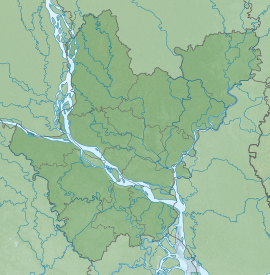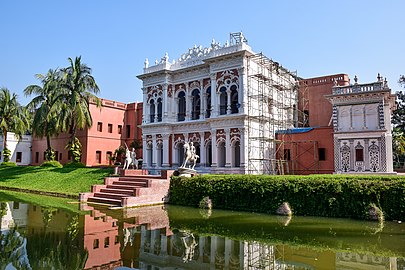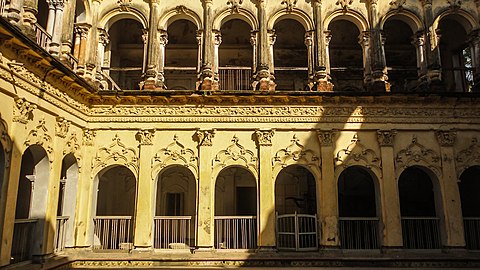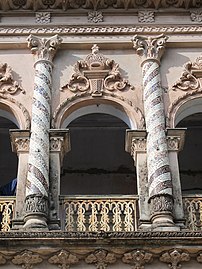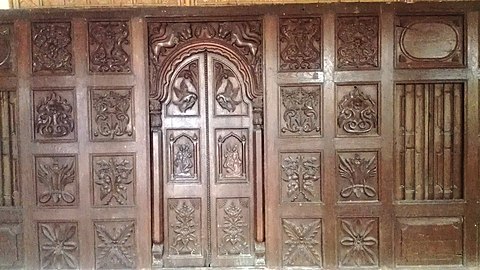Sonargaon
সোনারগাঁও | |
|
From top:Goaldi Mosque,Shilpacharya Zainul Folk Arts & Crafts Museum,Panam Nagar,Panam NagarArchitecture,Neel Kuthi,Taj Mahal Bangladesh | |
| Location | Narayanganj District,Dhaka Division,Bangladesh |
|---|---|
| Coordinates | 23°38′51″N90°35′52″E/ 23.64750°N 90.59778°E |
| History | |
| Founded | Antiquity |
| Abandoned | 19th century |
Sonargaon(Bengali:সোনারগাঁও;pronounced in Bengali asShow-naar-gaa;[1]lit.GoldenHamlet) is a historic city in centralBangladesh.It corresponds to theSonargaon UpazilaofNarayanganj DistrictinDhaka Division.
Sonargaon is one of the old capitals of the historic region ofBengaland was an administrative center of eastern Bengal. It was also ariver port.Its hinterland was the center of themuslin trade in Bengal,with a large population of weavers and artisans. According toancient Greek and Romanaccounts, anemporiumwas located in this hinterland, which archaeologists have identified with theWari-Bateshwar ruinsof theGangaridai Empire.The area was a base for theVanga,Gangaridai,Samatata,Sena,andDevadynasties.
Sonargaon gained importance during theDelhi Sultanate.It was the capital of the sultanate ruled byFakhruddin Mubarak Shahand his sonIkhtiyaruddin Ghazi Shah.It hosted a royal court andmintof theBengal Sultanateand also the capital of the Bengal Sultanate under the reign ofGhiyasuddin Azam Shah.Sonargaon became one of the most important townships in Bengal. Many immigrants settled in the area. The Sultans built mosques and tombs. It was later the seat of theBaro-Bhuyanconfederacy that resisted Mughal expansion under the leadership ofIsa Khanand his sonMusa Khan.Sonargaon then became a district ofMughal Bengal.DuringBritish colonial rule,merchants built manyIndo-Saracenictownhousesin the Panam neighborhood. Its importance was eventually eclipsed by the nearbyPort of Narayanganjwhich was set up in 1862.
Sonargaon draws many tourists each year in Bangladesh. It hosts theBangladesh Folk Arts and Crafts Foundation,as well as various archaeological sites, Sufi shrines, Hindu temples, and historic mosques and tombs.
History[edit]
Antiquity[edit]

Sonargaon is located near the old course of theBrahmaputra River.To the north of Sonargaon are theWari-Bateshwar ruins,which archaeologists have considered to be the emporium (trading colony) ofSounagouramentioned byGreco-Romanwriters.[2] The nameSonargaonoriginated with the ancient term ofSuvarnagrama.[3]Sonargaon was ruled byVangaandSamatataKingdoms during antiquity. TheSena dynastyused the area as a base. TheDeva dynastyKingDasharathadevashifted his capital fromBikrampurto Suvarnagrama in the middle of the 13th century.[3]Sonargaon is also one of the possible locations for the fabled land ofSuvarnabhumithat is referred in cultures across theIndian subcontinentand Southeast Asia.

Delhi Sultanate (13th and 14th centuries)[edit]
Muslim settlers first arrived in Sonargaon circa 1281.[4]In the early 14th century, Sonargaon became part of theDelhi SultanatewhenShamsuddin Firoz Shah,Delhi's governor inGauda,conquered central Bengal.[5]Firoz Shah built amintin Sonargaon from where a large number of coins were issued.[5]Delhi's governors in Bengal often tried to assert their independence. Rebel governors often chose Sonargaon as the capital of Bengal. When Firoz Shah died in 1322, his son,Ghiyasuddin Bahadur Shah,replaced him as ruler. In 1324, the Delhi SultanGhiyasuddin Tughlaqdeclared war against him and succeeded in capturing Bahadur Shah in battle. During the same year, SultanMuhammad bin Tughlaqreleased him and appointed him as the governor of Sonargaon.[6]
Sonargaon began to develop as a seat of Muslim learning andPersian literature.ManyPersianandPersianateTurkicimmigrants settled in Sonargaon. MaulanaSharfuddin Abu TawwamaofBukharacame to Sonargaon circa 1270 and established aSufikhanqahandmadrasa,which imparted both religious and secular education. The institutions became reputed throughout the Indian subcontinent. Sharfuddin Yahya Maneri, a celebrated Sufi scholar of Bihar, was an alumnus of Sonargaon. Tawwama's book on mysticism,Maqamat,enjoyed a strong reputation. During the administration of Roknuddin Kaikaus (1291-1301 AD), son ofNasiruddin Bughra Khan,Nam-i-Haq,a book on fiqh (jurisprudence), was written in elegant Persian poetry, in Sonargaon.[7]It is in 10 volumes and contains 180 poems. Though the authorship of this book has been ascribed to Shaikh Sharafu’d-Din Abu Tawwama, the author’s introduction testifies that the book was actually written by one of the disciples of Shaikh Sharafu’d-Din on the basis of his teachings.[7][8]TheFatwa-i-Tatarkhaniwas compiled at the initiative Tatar Khan, theTughluqgovernor of Sonargaon.[7]
Sonargaon Sultanate (14th century)[edit]
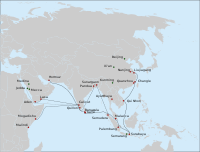
The Sultanate of Sonargaon became a short-lived independent state with control over central, northeastern and southeastern Bengal. When Bahram Khan died in 1338, his armour-bearer,Fakhruddin Mubarak Shah,declared himself the independent Sultan of Sonargaon.[4]Fakhruddin sponsored several construction projects, including atrunk roadand raised embankments, along with mosques and tombs.[10]Sonargaon began to conquer areas held by the eastern kingdoms of Arakan and Tripura. The army of Sonargaon conqueredChittagongin southeastern Bengal in 1340. In the west, Sonargaon competed with the neighboring city-states ofLakhnautiandSatgaonfor military supremacy in Bengal. Sonargaon prevailed in naval campaigns during themonsoon.Lakhnauti prevailed in land campaigns during the dry season.[11]The fourteenth-centuryMoorishtravelerIbn Battutavisited the Sonargaon Sultanate. He arrived through the port of Chittagong, from where he proceeded to the Sylhet region to meet withShah Jalal.He then proceeded to Sonargaon, the capital of the sultanate. He described Fakhruddin as "a distinguished sovereign who loved strangers, particularly the fakirs and sufis". In Sonargaon's river port, Ibn Battuta boarded aChinese junkwhich took him toJava.[12][10]After the death of Fakhruddin in 1349, his sonIkhtiyaruddin Ghazi Shahbecame the next independent ruler of Sonargaon.[13]The ruler of SatgaonShamsuddin Ilyas Shaheventually defeated Sonargaon in 1352 and established theBengal Sultanate.[14]
Bengal Sultanate (14th, 15th and 16th centuries)[edit]


The three city-states of Bengal were unified into an independent sultanate. There was a decisive break from the authority of Delhi. Sonargaon became one of the major townships in the eastern part of theIndian subcontinent.It was a strategically important river port with proximity to theBrahmaputra Valleyand theBay of Bengal.The third Bengali SultanGhiyasuddin Azam Shahestablished a royal court in Sonargaon. The township flourished as a center for writers, jurists and lawyers. The vast amount of Persian prose and poetry produced in Sonargaon during this period has been described as the "golden age of Persian literature" in Bengal.[8]The Sultan invited the Persian poetHafezto the Bengali court in Sonargaon. The institutions founded by Abu Tawwama were maintained by his successors, including the Sufi preachers Saiyid Ibrahim Danishmand, Saiyid Arif Billah Muhammad Kamel, Saiyid Muhammad Yusuf and others.[7]
During the 15th century, the ChineseTreasure voyagesincluded an expedition to Sonargaon. The Chinese embassies to Bengal were part of the mission ofAdmiral Zheng He.The information about this expedition comes from the book of one of its participants,Ma Huan.[1]In 1451, Ma Huan described Sonargaon as a fortifiedwalled city,[7]with a royal court, bazaars, bustling streets, water reservoirs, and a port.
During theHussain Shahi dynasty,Sonargaon was used as a base by the Sultans during campaigns againstAssam,TripuraandArakan.The Sultans launched raids into Assam and Tripura from Sonargaon.[15]The river port was vital during naval campaigns, such as during theBengal Sultanate-Kamata Kingdom Warand theBengal Sultanate–Kingdom of Mrauk U War of 1512–1516.
Sonragaon hosted amint.It was one of the most important townships in the Bengal Sultanate. It was the principal administrative center of eastern Bengal, particularly theBhatiregion. High officials of the Bengal Sultanate were based in Sonargaon.[15]Turkic,Arab,Habesha,Persian,PashtunandRajputsettlers migrated to the region and became Sonargaiyas. Sonargaon also became the eastern terminus of theGrand Trunk Road,which was built bySher Shah Suriin the 16th-century.[4]The Grand Trunk Road was a majortrade routestretching from Bengal to Central Asia. The prosperity of the Bengal Sultanate was attested by European travelers, includingLudovico di Varthema,Duarte BarbosaandTomé Pires.According to travelers, Sonargaon was an important commercial center. Many of its weavers and artisans wereHindus.When the Bengal Sultanate disintegrated in the late 16th-century, Sonargaon continued to be a bastion of Bengali independence for a few decades.
Baro Bhuiyans (late 16th and early 17th centuries)[edit]
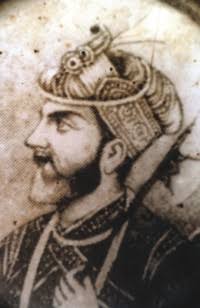
Under SultanTaj Khan Karrani,the noblemanIsa Khan,who was prime minister in the Sultan's court, gained anestatecovering the area of Sonargaon. TheKarrani dynastywas defeated byMughalforces in western Bengal. Isa Khan and aconfederationofzamindarsresisted Mughal expansion in eastern Bengal. The confederation is known as theBaro-Bhuyan(TwelveBhuiyans). The confederation includedBengali MuslimandBengali Hinduzamindars, many of whom hadTurkicandRajputancestry who eventually became Sonargaiya through time. Isa Khan gradually increased his strength and he was designated as the ruler of the wholeBhati region,with the title ofMansad-e-Ala.
In theAin-i-Akbari,Abul Fazlwrote about the "fine Bengali war boats" of Isa Khan's navy.[16]In theAkbarnama,Abul Fazl stated "Isa acquired fame by his ripe judgment and deliberateness, and made the twelve zamindars of Bengal subject to himself".[17]Isa Khan used theJangalbari Fort.In 1578, the Twelve Bhuiyans defeated Mughal viceroyKhan Jahan Iunder the leadership of zamindars Majlis Pratap and Majlis Dilawar, after Isa Khan was forced to retreat during a battle on theMeghna River.[18]In 1584, following an invasion byShahbaz Khan Kamboh,Isa Khan and Masum Khan Kabuli launched a successful land and naval counterattack inEgarosinduron the banks of the Brahmaputra River, which repulsed the Mughal invasion.[19]In 1597, Isa Khan's navy dealt a massive defeat to the Mughal Navy on thePadma River.The Mughals were led by viceroyMan Singh I,who lost his son in the battle. Isa Khan's navy had surrounded the Mughal fleet on four sides.[20]
In 1580, the English travelerRalph Fitchdescribed Isa Khan's kingdom, stating "for here are so many Rivers and Lands, that they (Mughals) flee from one to another, whereby his (Akbar) horsemen cannot prevail against them. Great store of cotton cloth is made here. Sinnergan (Sonargaon) is a towne sixe leagues from Serrepore, where there is the best and finest cloth made of cotton that is in all India. The chief king of all these countries is called Isacan (Isa Khan), and he is chief of all the other kings, and is a great friend to all Christians ".[21]In 1600, theJesuitMission stated that after the defeat of the Bengal Sultanate, "Twelve princes, however, called Boyones [bhūyān] who governed twelve provinces in the late King’s name, escaped from this massacre. These united against the Mongols [sic], and hitherto, thanks to their alliance, each maintains himself in his dominions. Very rich and disposing of strong forces, they bear themselves as Kings, chiefly he of Siripur [Sripur], also called Cadaray [Kedar Rai], and he of Chandecan [RajaPratapadityaof Jessore], but most of all the Mansondolin [ “Masnad-i ‘ālī,” title of Isa Khan]. The Patanes [Afghans], being scattered above, are subject to the Boyones. "[22]
Isa Khan died in September 1599. His son,Musa Khan,then took control of the Bhati region. The dictionaryShabda-Ratnakariwas compiled by the court poet Nathuresh during the reign of Musa Khan.[7]After the defeat of Musa Khan on 10 July 1610[23]to Mughal generalIslam Khan,Sonargaon became one of the districts ofBengal Subah.The capital of Bengal later developed in the new Mughal metropolis inDhaka.
Mughal rule (17th and 18th centuries)[edit]
Sonargaon was one of the districts (sarkars) of Mughal Bengal. The Mughals built several riverside fortifications near Sonargaon, as part of defences for the provincial capital Dhaka againstArakaneseandPortuguesepirates. These include theHajiganj FortandSonakanda Fort.The Mughals also built several bridges, including the Panam Bridge, Dalalpur Bridge and Panamnagar Bridge. The bridges are still in use.
- Mughal structures in and around Sonargaon
-
A 17th-century Mughal bridge over a decaying canal
British rule (18th, 19th and early 20th centuries)[edit]
DuringBritish rulein the 19th century, the neighborhood ofPanam Nagardeveloped with townhouses, offices, temples, and mosques. European architecture influenced the design of the neighborhood. Panam was a wealthy textile business center, particularly for cotton fabrics. The merchants includedBengali Hindus,MarwarisandBengali Muslims.[3]

Modern era[edit]
TheBangladesh Folk Arts and Crafts Foundationwas established in Sonargaon by Bangladeshi painterZainul Abedinon 12 March 1975.[4]The house, originally calledBara Sardar Bari,was built in 1901. On 15 February 1984,Narayanganjsubdivision was upgraded to a district by theGovernment of Bangladesh.[24]
A sub-district of Narayanganj District, formerly named Baidyabazar was renamed as Sonargaon. Due to the many threats to preservation (including flooding and vandalism), Sonargaon was placed in2008 Watch List of the 100 Most Endangered Sitesby theWorld Monuments Fund.[25]The present-day Sonargaon is a municipality in Narayanganj District.

Trade[edit]
Sonargaon was an ancient center ofmuslinproduction andtextile manufacturing.Sonargaon was famous for a cotton based cloth called Khasa for its finest quality.[26]The fertile farmland around the town also generated rice exports. The English traveler Ralph Fitch described the cotton textile weaving culture of the area in the 16th-century. Weavers formed a large part of the population. In 1580, he states "The houses here, as they be in the most part of India, are very little, and covered with straw, hay and a few mats round about the walls, and the door to keep out the Tygers and the Foxes. Many of the people are very rich. Here they will eat no flesh, nor kill no beast; They Hue of Rice, milke, and fruits, they go with a little cloth before them, and all the rest of their bodies is naked. Great store of cotton cloth goeth from hence, and much rice, wherewith they serue all India,Ceylon,Pegu,Malacca".[27]Sonargaon was ariver portwith access to theBay of Bengalthrough the mouth of the Bengali delta.[3]Maritime ships travelled between Sonargaon and southeast/west Asian countries.[3]
- Crafts and art of Sonargaon
Demographics[edit]
At the time of the 2011 census, Sonargaon Municipality had 7,289 households a population of 32,796. 6,952 (21.20%) were under 10 years of age. Sonargaon had a literacy rate of 62.57% and a sex ratio of 951 females per 1000 males.[29]
Notable Tourist Spots[edit]
Panam City:Panam City, located in Sonargaon Upazila of Narayanganj district, is a historic site and former commercial hub of Bengal. Nearly 400 years old, it features a blend of ancient Bengali, Mughal, and colonial architecture. The main attraction is Panam Nagar, with about 52 old brick mansions.
Sonargaon Folk Art and Craft Museum:Established in 1975, this museum preserves and displays traditional Bangladeshi folk art and crafts. Visitors can explore a rich collection of textiles, pottery, woodwork, and metal crafts.
Bara Sardar Bari:Built in 1901 by Zamindar Ishan Chandra Saha, Bara Sardar Bari is a palace showcasing Mughal architecture. It now serves as part of the Sonargaon Folk Art and Craft Museum, offering insights into the zamindari history of the region.
Goaldi Mosque:This 15th-century mosque is an exquisite example of Mughal architecture, known for its intricate carvings and historical significance.
Bangladesh’s Taj Mahal:Built in 2003 by Ahsanullah Moni as a tribute to his wife, this monument is a smaller but beautiful replica of the Taj Mahal in Agra.
Joynul Abedin Smriti Jadughar:A memorial dedicated to the artist Joynul Abedin, featuring his paintings, sketches, writings, and personal belongings.
Kadam Rasul Dargah:A significant religious site believed to house the footprint of Prophet Muhammad (PBUH), known for its architectural beauty.
Panch Pirer Mazar:A popular religious site in Bhagalpur village, attracting thousands of visitors annually for prayers and pilgrimage.
Baradi:A village known for its historical significance, including Esha Khan’s palace, Sonali Mosque, and Loknath Brahmachari’s ashram.[30]
See also[edit]
References[edit]
- ^abDuarte Barbosa;Mansel Longworth Dames (1996) [1918–1921].The book of Duarte Barbosa: An Account of the Countries Bordering on the Indian Ocean and Their Inhabitants.Asian Educational Services. pp. 138–139.ISBN81-206-0451-2.
- ^"A Family's Passion".Archaeology Magazine.
- ^abcdeMuazzam Hussain Khan,SonargaonArchived4 March 2016 at theWayback Machine,Banglapedia:The National Encyclopedia of Bangladesh,Asiatic Society of Bangladesh,Dhaka,Retrieved: 21 January 2012
- ^abcdGope, Rabindra (2011).A visitor's guide to the Sonargaon Museum.p. 3.ISBN978-984-33-2004-9.
- ^abABM Shamsuddin Ahmed,Shamsuddin Firuz ShahArchived4 March 2016 at theWayback Machine,Banglapedia:The National Encyclopedia of Bangladesh,Asiatic Society of Bangladesh,Dhaka,Retrieved: 21 January 2012
- ^Khan, Muazzam Hussain."Ghiyasuddin Bahadur Shah".Banglapedia.Retrieved27 July2015.
- ^abcdef"Sonargaon".Banglapedia.
- ^ab"Persian".Banglapedia.
- ^Dreyer, Edward L. (2006),Zheng He: China and the oceans in the early Ming dynasty, 1405–1433,The library of world biography, Pearson Longman,ISBN0-321-08443-8
- ^abMuazzam Hussain Khan,Fakhruddin Mubarak ShahArchived2 July 2015 at theWayback Machine,Banglapedia:The National Encyclopedia of Bangladesh,Asiatic Society of Bangladesh,Dhaka,Retrieved: 23 April 2011
- ^"Alauddin Ali Shah".Banglapedia.
- ^"Ibn Battuta".Banglapedia.
- ^Muazzam Hussain Khan,Ikhtiyaruddin Ghazi ShahArchived4 March 2016 at theWayback Machine,Banglapedia:The National Encyclopedia of Bangladesh,Asiatic Society of Bangladesh,Dhaka,Retrieved: 21 January 2012
- ^ABM Shamsuddin Ahmed,Iliyas ShahArchived4 November 2016 at theWayback Machine,Banglapedia:The National Encyclopedia of Bangladesh,Asiatic Society of Bangladesh,Dhaka,Retrieved: 21 January 2012
- ^ab"Goaldi Mosque in Sonargaon".Dhaka Tribune.22 December 2019.
- ^Nidhi Dugar Kundalia (24 December 2015).The Lost Generation: Chronicling India's Dying Professions.Random House India. p. 93.ISBN978-81-8400-776-3.
- ^Chisti, A.A. Sheikh Md. Asrarul Hoque (October 2013).The Bara-Bhuiyans and Their Times: A Study of the local anti-Mughal Resistance in Bengal (1576-1612 A.C.)(PDF)(PhD). University of Dhaka. Archived fromthe original(PDF)on 16 September 2016.
- ^"Isa Khan".Banglapedia.
- ^Kunal Chakrabarti; Shubhra Chakrabarti (22 August 2013).Historical Dictionary of the Bengalis.Scarecrow Press. p. 257.ISBN978-0-8108-8024-5.
- ^Richard Maxwell Eaton (1996).The Rise of Islam and the Bengal Frontier, 1204-1760.University of California Press. p. 148.ISBN978-0-520-20507-9.
- ^Ryley, J. Horton (John Horton) (1899)."Ralph Fitch, England's pioneer to India and Burma; his companions and contemporaries, with his remarkable narrative told in his own words".London, T.F. Unwin.
- ^Richard Maxwell Eaton (1996).The Rise of Islam and the Bengal Frontier, 1204-1760.University of California Press. p. 146.ISBN978-0-520-20507-9.
- ^Feroz, M A Hannan (2009).400 years of Dhaka.Ittyadi. p. 12.
- ^Md Solaiman,NarayanganjArchived7 March 2016 at theWayback Machine,Banglapedia:The National Encyclopedia of Bangladesh,Asiatic Society of Bangladesh,Dhaka,Retrieved: 21 February 2012
- ^"2008 World Monuments Watch List of 100 Most Endangered Sites"(PDF).World Monuments Fund.Archived fromthe original(PDF)on 20 March 2013.Retrieved27 July2015.
- ^S. B. Chakrabarti, Ranjit Kumar Bhattacharya (2002).Indian Artisans: Social Institutions and Cultural Values.Anthropological Survey of India, Government of India, Ministry of Culture, Youth Affairs and Sports, Department of Culture. p. 87.ISBN9788185579566.
- ^Ryley, J. Horton (1899)."Ralph Fitch".
- ^"Bangladesh Population and Housing Census 2011 Zila Report – Narayanganj"(PDF).bbs.gov.bd.Bangladesh Bureau of Statistics.
- ^"Community Tables: Narayanganj district"(PDF).bbs.gov.bd.Bangladesh Bureau of Statistics.2011.
- ^"Sonargaon: Ancient Capital of Bangladesh - RBS Property".20 June 2024.Retrieved10 July2024.
Further reading[edit]
- Kazi Azizul Islam and Tania Sharmeen (5 July 2005)."Panam Among World's 100 Endangered Historic Sites".News from Bangladesh.
- Roy, Pinaki (9 July 2004)."Panam Nagar's Fate in Limbo".The Daily Star.
- Ali, Tawfique (26 April 2007)."Unscientific Restoration Defacing Heritage".The Daily Star.







